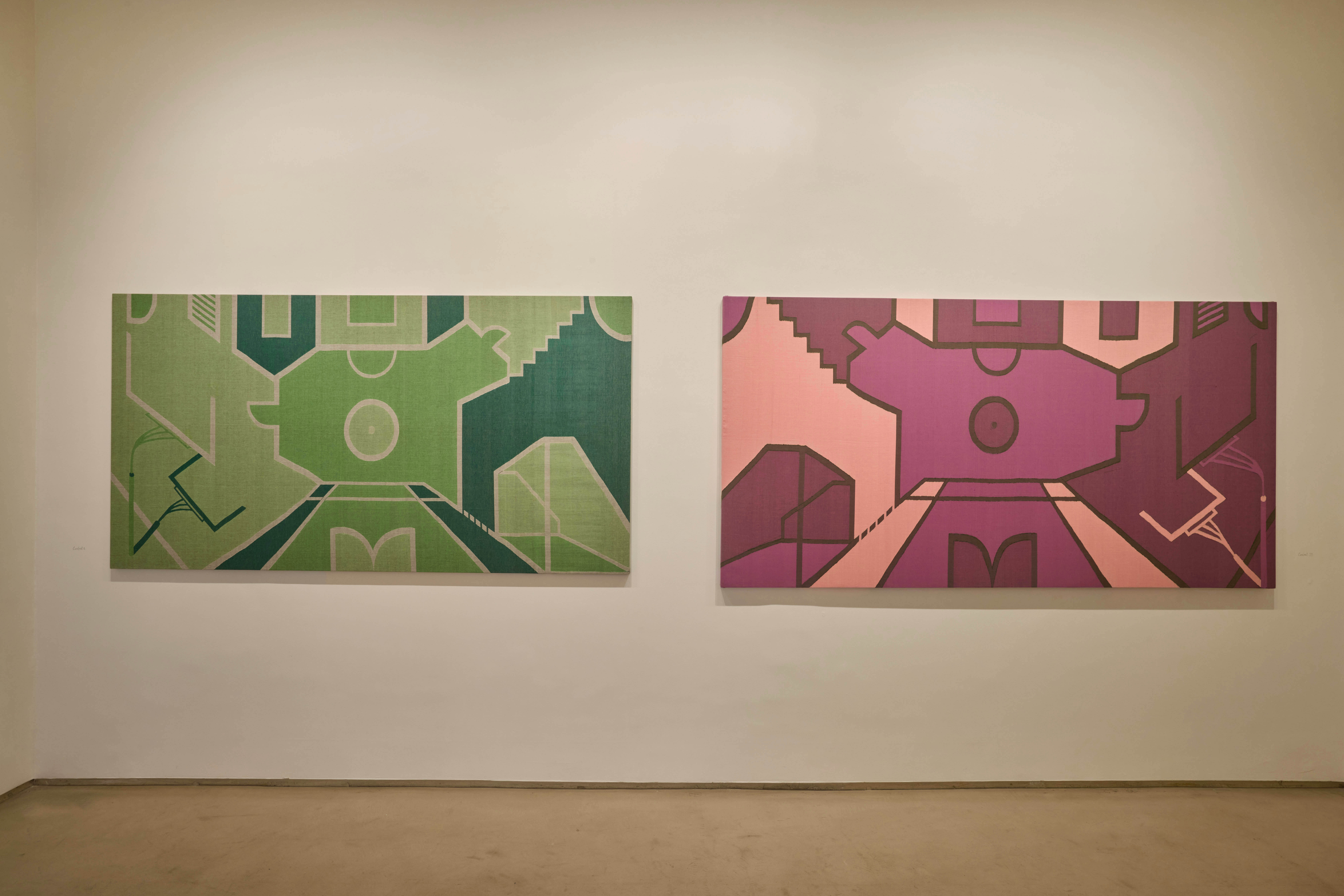On a quiet March afternoon, just as the light had softened, I went to Experimenter Colaba in Mumbai, Ground Control, a solo show by Kanishka Raja (1969 – 2018). The gallery’s exposed rafters and old arched windows resonated instantly with forms in the artwork and made for the perfect canvas— not quite a white cube — for a show that responded to architecture and urbanity. The first edition of Ground Control opened in Experimenter Kolkata in August 2022, and while the Colaba edition was condensed, with thirteen works spread across four rooms (or galleries), the visitor was instantly drawn into the various “grounds” that Kanishka Raja so meticulously created.

Kanishka Raja, Control 1, 2014, Handwoven double weft cotton thread, 45 x 85 in. Image Courtesy: The Estate of Kanishka Raja, Juli Raja and Experimenter.
Bright as a computer game on a screen, Ground Control began with references to music, borrowing its title from David Bowie, and has an aerial perspective, if not the tin-can view. Is the artist Ground Control and who is Major Tom? The roles reverse playfully, and the show, like a game, moves effortlessly between footprints of buildings, courts and playing fields, and outlines of urban spaces. The vibrant several shades of colour — earthy oranges and reds, purples, greens, blues — are interspersed with bold white lines, which resemble chalk or markers on a field. These lines thread through artworks and can be followed across the gallery. Some lines are strong and define boundaries, while others break and curve, indicating doors, windows, and stairs, which literally and metaphorically allow for openings, points of entry and exit, and movement. Several lines have shadows, which add depth to the image, creating illusions of three-dimensionality on a flat, 2-D artwork. There is a play on perspective, especially in the architectural images, where houses seem to pop out of the frame.
When encountering Ground Control for the first time, the medium of the works is not immediately discernible. The texture of the artworks requires the viewer to step closer, and see these are not paintings but tapestries! In addition to large “woven paintings” the display includes a few small works on paper. This juxtaposition draws attention to Raja’s multi-layered and collaborative process. While the conception of the work treads on the artist’s personal interest in sports, Bauhaus architecture, design, and music, the art is created in a two-fold process. Raja made studies on paper and worked closely with master craftspeople in Bengal to translate the image onto fabric. These double-weft handwoven textiles are complex not just in their technique, but also in the masterful adaptation of Raja’s lines, gradients of colour, and design. Kanishka Raja worked in Brooklyn, New York, and sent his instructions to Phulia in West Bengal, where the artworks were woven. Once ready, the textiles made the journey to the United States, to be stretched and mounted in New York, and travelled further to exhibitions around the world.

Kanishka Raja, Control 10, 2015, Handwoven double weft cotton thread; Diptych, 91 x 49 in & 87 x 48 in(R), Image Courtesy: The Estate of Kanishka Raja ,Juli Raja and Experimenter. Collection of Kiran Nadar Museum of Art.
Now in Mumbai, a city that’s being excavated for new public transport (the metro) and re-built constantly, the artworks take on a new set of meanings, reminding us of what is lost, what is constructed, and the tension between the literal lack of ground, and the need for space to live, play sports, and, of course, for infrastructure! Ground Control shows Raja’s facility with lines and design, as well as ease with the process of craft and art-making. Raja’s deep engagement with textiles is evident, as is his love for textiles. His ability to play with form and technique shines through his work, allowing for improvisation and spontaneity, within the framework of the loom, of paper, and of the frame, as a finished work of art.

Kanishka Raja, Study for Control 7, Drawing on paper, 36 x 65 in , All Images Courtesy: The Estate of Kanishka Raja, Juli Raja and Experimenter.
The woven paintings create intimate spaces of interaction and engagement, but underline the absence, perhaps felt acutely because the artist is no more. Having encountered Kanishka Raja’s work, an artist’s book, which sits quietly on a pedestal, gives us a glimpse into the life and mind of the artist. This slim volume, beautifully designed and produced, maps Raja’s journey between Kolkata and New York with photographs from Raja’s archive, artworks, excerpts of his writings— some of them very poetic and personal — and interviews.
While one expects a posthumous show to be melancholic, Ground Control is not sombre. The artworks have a subtext of irony, even stubborn optimism, making the show come across as joyful. This is, perhaps, a suitable commemoration of Kanishka Raja’s vibrant practice, and his promising but tragically short life.
Ground Control, Solo Show of Kanishka Raja, Experimenter Colaba, 9 March – 13 May 2023.
#GroundControl, #SoloShow, #KanishkaRaja, #ExperimenterColaba #artreview #takeonart #takewriting #takecurator #artcurator #artwriting #artcritics #artpublications #curatorialwriting #artcriticism #arthistories #artdiscousre #artcollaboration #artcreatives #artcommunities #arthistory #criticaldiscourse













